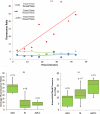Nanoparticle uptake in tumors is mediated by the interplay of vascular and collagen density with interstitial pressure
- PMID: 22841910
- PMCID: PMC3505807
- DOI: 10.1016/j.nano.2012.07.002
Nanoparticle uptake in tumors is mediated by the interplay of vascular and collagen density with interstitial pressure
Abstract
Nanoparticle delivery into solid tumors is affected by vessel density, interstitial fluid pressure (IFP) and collagen, as shown in this article by contrasting the in vivo macroscopic quantitative uptake of 40 nm fluorescent beads in three tumor types.The fluorescence uptake was quantified on individual animals by normalization with the transmitted light and then normalized to normal tissue uptake in each mouse. Mean data for uptake in individual tumor lines then showed expected trends with the largest uptake in the most vascularized tumor line. Tumor lines with increased collagen were also consistent with highest interstitial fluid pressure and correlated with lowest uptake of nanoparticles. The data is consistent with a delivery model indicating that while vascular permeability is maximized by neovascular growth, it is inhibited by collagen content and the resulting interstitial pressure. Imaging of these parameters in vivo can lead to better individual noninvasive methods to assess drug penetration in situ.
From the clinical editor: In this manuscript the dependence of nanoparticle delivery is addressed from the standpoint of vascular factors (the more vascularized, the better delivery) and as a function of collagen density and interstitial pressure (the higher these are, the worse the delivery).
Copyright © 2013 Elsevier Inc. All rights reserved.
Figures






References
-
- I H, R H, R H. Thermal Ablation of Tumors Using Magnetic Nanoparticles An In Vivo Feasibility Study. Investigative Radiology. 2002;37:580–586. - PubMed
-
- Cho K, Wang X, Nie S, Cho K, Wang X, Nie S, Chen ZG, Shin DM. Therapeutic Nanoparticles for Drug Delivery in Cancer Therapeutic Nanoparticles for Drug Delivery in Cancer. Clinical Cancer Research. 2008:1310–1316. - PubMed
-
- Petros RA, Desimone JM. Strategies in the design of nanoparticles for therapeutic applications. Nature Reviews Drug Discovery. 2010;9(8):615–627. - PubMed
Publication types
MeSH terms
Substances
Grants and funding
LinkOut - more resources
Full Text Sources
Other Literature Sources

